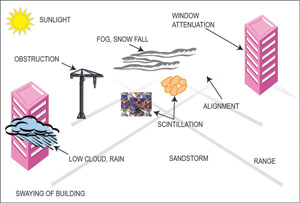This technology offers better interoperability with fibre networks and delivers scalable bandwidth supporting all protocols. Moreover, FSO technology’s narrow beam transmission is typically two metres versus twenty metres and more for traditional, even newer radio-based technologies such as millimetre-wave radio. The lasers emit very sharp, focussed and narrow (small angle/small divergence) invisible light that results in very small spot size at a long distance (spot diameter (m) = angle (milliradians)×range (km)). This makes FSO hard to intercept, making it ideal for high-security applications such as financial, military and medical activities.
Fourth-generation FSO systems offer exclusive automatic power-level control, eliminating short-distance optical saturation found in first-generation systems. The latest fourth-generation FSO lasers are 100 per cent class 1M eye-safe technology. Also, they employ active tracking multiple-beam solution. Such systems eliminate mistargeting and provide parallel beam redundancy, solving problems such as a bird flying through the path of a first-generation FSO system.
FSO network topologies
Several network topologies are possible for FSO networks. PTP, star, ring and mesh are all feasible network architectures for laser communications. PTP topology is the simplest of the physical layouts of network devices. PTP connections mean that two devices (nodes) have a single path for data to travel between them with nothing breaking up that path.
On the other hand, in star connections, all devices are connected to a central hub utilising independent links. The central node is usually a hub or a multiplexer that utilises repeaters to forward data.
In a ring topology, all nodes are connected to one another in the shape of a closed loop, so that each node is connected directly to two other nodes, one on either side of it.
In a mesh topology, devices are connected with many redundant interconnections between network nodes. Each node is connected with two to four nodes and is able to receive, transmit and forward data packets. All topologies comprise a combination of PTP links.

Additionally, hybrid topologies including ring, mesh, PTP and/or star interconnections have been proposed for FSO systems (Fig. 3). In ring interconnections, customer nodes can be ring nodes of more than one ring or one hop away from another ring. At the same time, PTP connections with nodes that do not belong to the ring can exist. On the other hand, in star interconnections, central nodes (hubs) are connected with other central nodes utilising PTP links. The primary reason of extending the standard network topologies is the increase of reliability and coverage area whilst keeping the associated cost low.
The choice of network topology significantly affects the performance, reliability, scalability, design complexity and overall cost of a free-space optics network.
Challenges
There are several signal propagation impediments for FSO that affect light propagation through free space. The turbulences in the signal may be due to absorption, diffraction, scattering, refraction, beam wander, scintillation, beam dispersion, etc that may be caused by physical composition of atmosphere, changes in refractive indices, building sway, fog, rain, dust, smog, snow, interference from background light sources (including the sun), shadowing, etc (Fig. 4).
1. Environmental factors. Fog. Fog is composed of water droplets between a few and a hundred microns in diameter, which allow absorption, scattering and reflection to occur when laser beams pass through it. Fog is a major challenge to FSO communications and can result in atmospheric attenuation of signal (10-100 dB/km). Heavy fog can result in a complete outage of the service.
Low clouds, rain, snow and dust. Low clouds are very similar to fog and may accompany rain and snow that may degrade optical signal significantly.
Rain. Rain can also degrade the performance of FSO transmission. Raindrop sizes are larger than fog so may cause scattering of optical signal. Extremely heavy rain can entirely disrupt the link. Water sheeting on windows can also deteriorate signal.
Heavy snow. Heavy snow may cause whiteout conditions and may result in ice build-up on windows. Laser beams are affected by heavy snow and rain that can cause attenuation to the laser beams of 60-1000 dB/km.
Sandstorms. Sand/dust particles can alter signal path to a finite extent. In desert areas, sandstorms occur very often but they occur rarely in urban areas.
The phenomenon that causes signal degradation due to atmospheric conditions is explained in the following lines:
Absorption. Absorption occurs when suspended water molecules in the terrestrial atmosphere extinguish photons. This causes a decrease in the power density of the FSO beam and directly affects the availability of telecom services. However, typical wavelength values of FSO systems are 785nm, 850nm and 1500nm. These wavelengths correspond to atmospheric windows where the attenuation is very small; thus the absorption attenuation also is very small.






